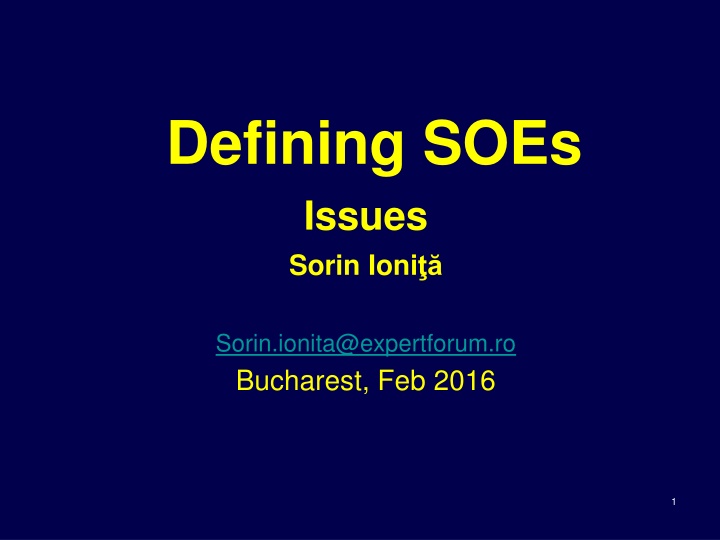
State-Owned Enterprises: Exploring Issues and Policies
Delve into the purpose and challenges of State-Owned Enterprises (SOEs), including reasons for their existence, overlaps with Specialised Entities (SGEIs), and the diverse nature of SOEs in terms of profit orientation. Learn about the implications of SOEs on various sectors and their impact on the economy.
Download Presentation

Please find below an Image/Link to download the presentation.
The content on the website is provided AS IS for your information and personal use only. It may not be sold, licensed, or shared on other websites without obtaining consent from the author. If you encounter any issues during the download, it is possible that the publisher has removed the file from their server.
You are allowed to download the files provided on this website for personal or commercial use, subject to the condition that they are used lawfully. All files are the property of their respective owners.
The content on the website is provided AS IS for your information and personal use only. It may not be sold, licensed, or shared on other websites without obtaining consent from the author.
E N D
Presentation Transcript
Defining SOEs Issues Sorin Ioni Sorin.ionita@expertforum.ro Bucharest, Feb 2016 1
Why do SOEs exist (OECD) 1. Natural monopolies (ex infrastructure): roads, water-sewage, energy mains, etc 2. Imperfect contracts: high externalities, unpredictable trends, effective regulation would be too complex / costly (forests, other nat assets, airports, hydro) 3. Incumbent operators (ex postal serv): burdensome social service obligation, costly regulation 2
Why do SOEs exist (OECD) 4. Industrial policy (the most fuzzy): - Various social goals: employment, regional balance, strategic ind (?) - promote R & D - infant industry argument - in ECE, legacies of inherited industry (Oltchim), network effects , etc 3
Why do SOEs exist (OECD) Observations: For (1-3) it is crucial to separate in our analysis the commercial / public service obligation parts; not always easy (4) raises even more problems, depending how we define clientelism. One person s industrial policy = other person s clientelism (rent seeking at the expense of wider society) 4
SOEs SGEIs (EU) EU has a special regulatory regime on a special class of entities: SGIs / SGEIs. Justified with market failure arguments. They get special treatment under competition laws (exceptions); special directives The real, tricky problems: the SGEIs They overlap with SOEs, but not perfectly 5
SOEs SGEIs (EU) SGEIs SOEs Some SOEs fall under the directive, some don t 6
The profit motive Two broad categories A. SOEs purely profit based, 100% economic activity but happen to be state owned (for various reasons, but mainly in category 4): CFR Marfa, coal mines, Oltchim, Romgaz, Tarom 7
The profit motive B. SOEs which operate more like the public administration, get budget money, have taxes assigned, legal monopoly. They are not paid by clients, but mostly by taxpayers CNADNR the national roads company TVR / national Radio Various research institutes 8
The profit motive Many SOEs fall between A and B: Must by mandate (1) realize profit from operations (or at least maximize revenues) Have social obligations conflicting with the first mandate (profit): ensure uniform service in territory (Post, urban transport, water-sewage); protect natural resources & risk control (forestry, water company, hydropower); inform the public, etc 9
The profit motive The balance between the two sets of goals must be: Clearly defined in policy and measurable Written into the contracts SOEs must be compensated by the state (central/local) for the public service obligations performed In general (at least ECE) none of these is true 10
SOEs in our project Selection 1. How many: 10-15 per country? 2. Limit for state ownership: 50%+1? Higher? Lower (state below 50% but with golden share or strong corporate control)? 3. Diversity: (a) relevant sectors; (b) central / local, regional; (c) listed / not listed 4. SOEs with / without public service obligations: we must be able to distinguish and estimate it later on 11
SOEs in our project 5. SOEs for profit / not for profit (under general company law or not regies autonomes); ex. Netherlands does not have the latter 6. Risk profile / history: previous fraud scandals; credible media stories; national auditor reports; case law 7. Ensure comparability across the 4 countries (as much as possible) 12
